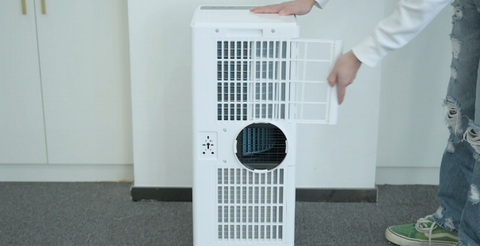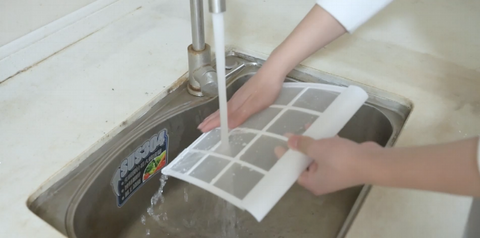Portable air conditioners are a convenient way to cool a room without the need for a central cooling system. They are also easy to move from one room to another. However, like any other appliance, they need regular maintenance to function efficiently. In this blog, we will discuss how to maintain and clean your portable air conditioner.
1. Regular cleaning of air filters
Keeping your portable air conditioner (AC) clean and well-maintained is essential for efficient operation, longer lifespan, and better air quality in your home or office. One of the most critical parts of maintaining your portable AC is cleaning the filter regularly. Dirty filters can reduce airflow, making the unit work harder and consume more energy, leading to higher electricity bills. In addition, dirty filters can also reduce the quality of the air that circulates in your room, making it more difficult to breathe for people with allergies or respiratory issues.
Here's a step-by-step guide on how to clean the filter of your portable AC:
Turn off and unplug the unit – Safety first! Before cleaning your portable AC filter, make sure to turn it off and unplug it from the electrical outlet.
Locate the filter – Most portable AC units have a removable filter located at the back or the side of the unit. Refer to your user manual if you're not sure where the filter is located.
Remove the filter – Gently pull the filter out of its housing. Depending on the model, you may need to slide or push a button to remove the filter.

Vacuum the filter – Using a vacuum cleaner with a soft brush attachment, carefully remove any dirt, dust, or debris from the filter. You can also use a soft-bristled brush to gently remove any stubborn dirt or debris.
Wash the filter – If the filter is washable, rinse it under running water and use a mild detergent to clean it thoroughly. Avoid using hot water or harsh chemicals that could damage the filter. Make sure to rinse the filter thoroughly and let it dry completely before putting it back into the unit.

Reinstall the filter – Once the filter is completely dry, place it back into its housing and secure it in place.
2. Clean the condenser coil and exhaust hose
Cleaning the condenser coils and drains of your portable air conditioner is also an essential step in maintaining its efficiency and prolonging its lifespan. Over time, these components can accumulate dirt, dust, and other debris, which can reduce the unit's cooling power and cause it to work harder than necessary.
To clean the condenser coils, you'll need to remove the cover or grille on the back of the AC unit. Use a soft brush or vacuum cleaner to remove any visible debris, such as dust and dirt, from the coils. You can also use a coil cleaner solution to dissolve and remove any stubborn dirt or grime.
Next, locate the condenser drain and remove any blockages that may have accumulated over time. You can use a small brush or a pipe cleaner to clear out any debris or dirt from the drain. Ensure that the drain is free from blockages to prevent any water from overflowing, which can cause damage to your unit.

Finally, wipe down the exterior of the unit with a damp cloth to remove any remaining dirt or dust. Allow the unit to dry completely before replacing the cover or grille.
Cleaning the condenser coils and drains should be done at least once a year, or more frequently if you use your portable AC frequently or in dusty environments. By regularly cleaning these components, you can help your unit to work more efficiently, save energy, and prolong its lifespan.
3. Clean the exterior of the air conditioner
Keep the exterior clean
Apart from draining the water and replacing the filters, make sure you also clean the exterior of your unit every few weeks. When the unit is switched off, use a soft, damp cloth to wipe the surface clean. Steer clear of abrasive chemicals or harsh detergents as they may damage the surface.
4. End-of-season storage and maintenance
End-of-season storage and maintenance is an essential part of owning a portable air conditioner. Here are some tips to help you properly store and maintain your unit when it's not in use:
As summer comes to an end and the temperature starts to drop, it's time to start thinking about storing your portable air conditioner until next year. Properly storing your AC unit will help to extend its lifespan and ensure that it's ready to go when the next heatwave hits. Here are some tips for end-of-season storage and maintenance for your portable air conditioner.
Drain the tank and clean the filter
Before you store your portable AC unit, be sure to drain the tank and clean the filter. This will prevent any buildup of mold or bacteria while it's in storage. Follow the manufacturer's instructions for draining the tank and removing the filter. Clean the filter with warm, soapy water and allow it to dry completely before reinstalling it.
Run the unit in fan mode
After cleaning the filter and draining the tank, run the portable air conditioner in fan mode for 30 minutes to an hour. This will help to eliminate any excess moisture that may have accumulated inside the unit. Be sure to let everything dry completely before packing it away.
Store the unit in its original packaging
If possible, store your portable air conditioner in its original packaging. The packaging is designed to protect the unit during transportation and storage, so it's the best option for long-term storage. If you don't have the original packaging, find a sturdy box that's big enough to fit the unit and any accessories.
Find a clean and dry place to store the unit
Once you've packed away your portable air conditioner, find a clean and dry place to store it. Avoid storing it in a damp basement or garage, as this can lead to mold growth and damage to the unit. Instead, find a closet or storage room that's free from moisture and dirt.
Check on the unit periodically
While your portable air conditioner is in storage, be sure to check on it periodically. Every few weeks, turn it on for a few minutes to ensure that everything is working properly. This will help to prevent any issues that may arise from prolonged storage.
By following these simple steps, you can ensure that your portable air conditioner is ready to go when the next heatwave hits. Proper storage and maintenance will help to extend the life of your unit and keep your home cool and comfortable all summer long.


